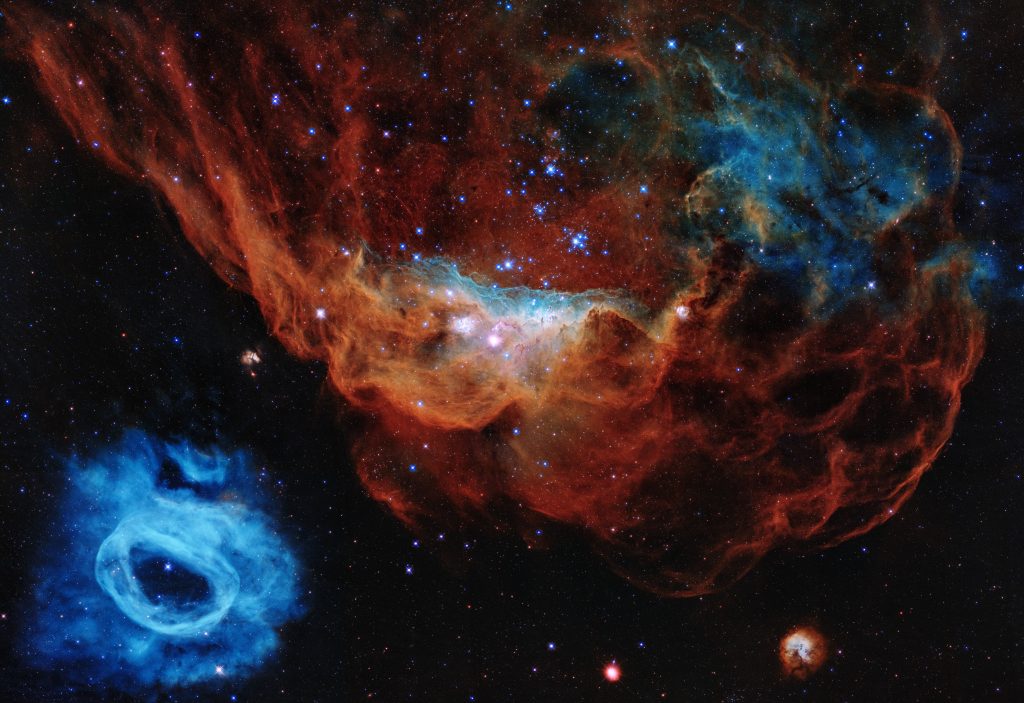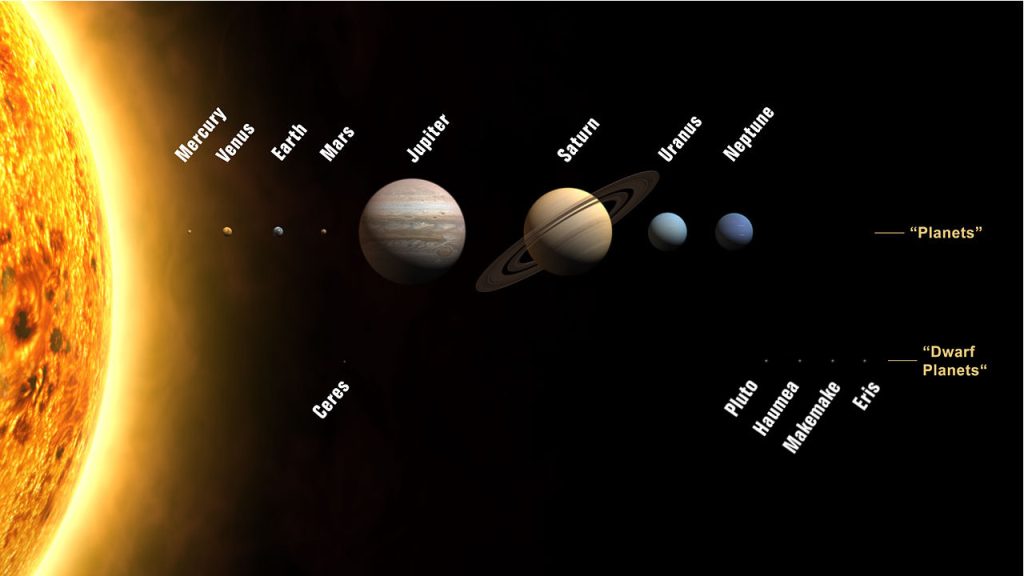2.1 Our Solar System and Earth
R. Adam Dastrup; Laura J. Brown; and Jaclyn Cockburn
There are many planetary systems in the Universe. Like our Solar system, they have a star and planets that orbit it. Our star is the Sun; our solar system formed about 4.5 billion years ago. The nebula hypothesis is the most widely accepted explanation of how our Sun and the planets formed. A spinning dense cloud of interstellar dust and gas collapsed, forming a solar nebula. Space telescopes like Hubble and James Webb beam back images of solar nebulas much like the one that formed our solar system, which are beautiful (Figure 2.1).

Every nebula is different in its concentrations of gases and dust composition. The nebula that formed our solar system was rich in nitrogen, oxygen, iron and silica, along with all the other gases and elements that were needed to form the Sun, planets, and other astral bodies.
As the nebula collapsed, gravity started to sort the elements and pull more material toward the centre. Elements and matter started to coalesce to form a star and planets. Eventually, the pressure in the centre was so great that hydrogen atoms began to combine to form helium and, in doing so, released massive amounts of energy, creating a star. This star is our Sun.
As the Sun formed, gravity also pulled material together in other parts of the nebula. As gases and dust collided, clumps formed and grew larger by accretion. Some objects grew large enough to develop their own gravity and took on a spherical shape. These spheres are our planets, smaller dwarf planets and moons. Nearest to the Sun, the four rock planets developed, Mercury, Venus, Earth, and Mars (Figure 2.2). Further out, Jupiter, Saturn, Uranus, and Neptune, the four gas planets, formed. Asteroids, comets and stardust are left from the material that did not become part of the Sun, planets, or moons.

Earth as a Planetary Body
Like the other rocky inner planets, Earth is a sphere. Or, more correctly, an oblate spheroid, which is a sphere that is a bit squished down at the poles and bulges a bit at the equator. Even the ancient Greeks knew that Earth was round by observing the arc shape of the shadow on the Moon during a lunar eclipse. The Sun and the other planets of the solar system are also spherical. Larger astral bodies, those with enough mass for their gravitational attraction to have made them round, are spheroidal too.
Earth has a magnetic field that behaves as if the planet had a gigantic bar magnet inside of it. Earth’s magnetic field also has a north and south pole and a magnetic field surrounding it. The magnetic field arises from molten iron and nickel metal convection in Earth’s outer liquid iron core. Earth’s magnetic field extends several thousand kilometres into space. The magnetic field shields the planet from harmful radiation from the Sun.
Earth’s Rotation
Imagine a line passing through the center of Earth that goes through both the North and South Pole. This imaginary line is called an axis. Earth spins around its axis, just as a top spins around its spindle. This spinning movement is called the Earth’s rotation. While the Earth spins on its axis, it also orbits or revolves around the Sun.
An observer in space will see that Earth requires 23 hours, 56 minutes, and 4 seconds to make one complete rotation on its axis. However, because Earth moves around the Sun simultaneously as rotating, the planet must turn just a bit more to reach the same place relative to the Sun. Hence the length of a day on Earth is 24 hours. At the equator, the Earth rotates at a speed of about 1,700 km per hour, but at the poles, the movement speed is nearly nothing.

Earth’s Revolution
For Earth to make one complete revolution around the Sun takes 365.24 days. This amount of time is the definition of one year. The gravitational pull of the Sun keeps Earth and the other planets in orbit around itself. Like the other planets, Earth’s orbital path is an ellipse, so the planet is sometimes farther away from the Sun than at other times. The closest Earth gets to the Sun each year is at perihelion (147 million km) on about January 3, and the furthest is at aphelion (152 million km) on July 4. Earth’s elliptical orbit has nothing to do with Earth’s seasons.
During one revolution around the Sun, Earth travels at an average distance of about 150 million km. Earth revolves around the Sun at an average speed of about 27 km per second, but the speed is not constant. The planet moves slower when it is at aphelion and faster when it is at perihelion.
Seasons
The Earth has seasons because it is tilted 23.5º on its axis, along with its daily rotation and annual revolution around the sun. During the Northern Hemisphere summer, the North Pole points toward the Sun, and in the Northern Hemisphere winter, the North Pole has tilted away from the Sun.

The Tropic of Cancer is the parallel at 23.5 º north of the equator, which is the most northerly place on Earth, receiving direct sunlight during the Northern Hemisphere’s summer. Remember that the earth is tilted 23.5 degrees, which accounts for seasonal variations in climate. The Tropic of Capricorn is the parallel at 23.5 degrees south of the equator and is the most southerly location on Earth, receiving direct sunlight during the Southern Hemisphere’s summer.
The tropics (Cancer and Capricorn) are the two imaginary lines directly above which the sun shines on the two solstices, which occur on or near June 20 or 21 (summer solstice in the Northern Hemisphere) and December 21 or 22 (winter solstice in the Northern Hemisphere). The sun is directly above the Tropic of Cancer at noon on June 20 or 21, marking the beginning of summer in the Northern Hemisphere and the beginning of winter in the Southern Hemisphere. The sun is directly above the Tropic of Capricorn at noon on December 21 or 22, marking the beginning of winter in the Northern Hemisphere and the beginning of summer in the Southern Hemisphere. Solstices are the extreme ends of the seasons, when the line of direct sunlight is either the farthest north or the farthest south that it ever goes. The region between the Tropics of Cancer and Capricorn is known as the tropics. This area does not experience dramatic seasonal changes because the amount of direct sunlight received does not vary widely. The higher latitudes (north of the Tropic of Cancer and south of the Tropic of Capricorn) experience significant seasonal variation in climate.
The Arctic Circle is a line of latitude at 66.5º north. It is the farthest point north that receives sunlight during its winter season (90º N − 23.5º = 66.5º N). During winter, the North Pole is away from the sun and does not receive much sunlight. At times, it is dark for most of the 24-hour day. During the Northern Hemisphere’s summer, the North Pole faces more toward the sun and may receive sunlight for extended periods of the 24-hour day. The Antarctic Circle is the corresponding line of latitude at 66.5º south. It is the farthest location south that receives sunlight during the winter season in the Southern Hemisphere (90º S − 23.5º = 66.5º S). When it is winter in the northern hemisphere, it is summer in the southern hemisphere.
The Arctic and Antarctic Circles mark the extremities (southern and northern, respectively) of the polar day (24-hour sunlit day) and the polar night (24-hour sunless night). North of the Arctic Circle, the sun is above the horizon for twenty-four continuous hours at least once per year and below the horizon for twenty-four continuous hours per year. This is true also near the Antarctic Circle, but it occurs south of the Antarctic Circle, toward the South Pole. Equinoxes, when the line of direct sunlight hits the equator and days and nights are of equal length, occur in the spring and fall on or around March 20 or 21 and September 22 or 23.

